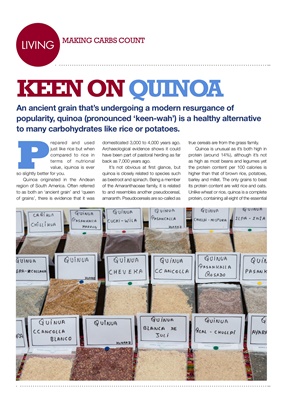
LIVINGLIVING MAKING CARBS COUNT
An ancient grain that's undergoing a modern resurgance of
popularity, quinoa (pronounced 'keen-wah') is a healthy alternative
to many carbohydrates like rice or potatoes.
KEEN ON QUINOA
P
repared and used
just like rice but when
compared to rice in
terms of nutrional
value, iquinoa is ever
so slightly better for you.
Quinoa originated in the Andean
region of South America. Often referred
to as both an 'ancient grain' and 'queen
of grains', there is evidence that it was
domesticated 3,000 to 4,000 years ago.
Archaeological evidence shows it could
have been part of pastoral herding as far
back as 7,000 years ago.
It's not obvious at first glance, but
quinoa is closely related to species such
as beetroot and spinach. Being a member
of the Amaranthaceae family, it is related
to and resembles another pseudocereal,
amaranth. Pseudocereals are so-called as
true cereals are from the grass family.
Quinoa is unusual as it's both high in
protein (around 14%), although it's not
as high as most beans and legumes yet
the protein content per 100 calories is
higher than that of brown rice, potatoes,
barley and millet. The only grains to beat
its protein content are wild rice and oats.
Unlike wheat or rice, quinoa is a complete
protein, containing all eight of the essential